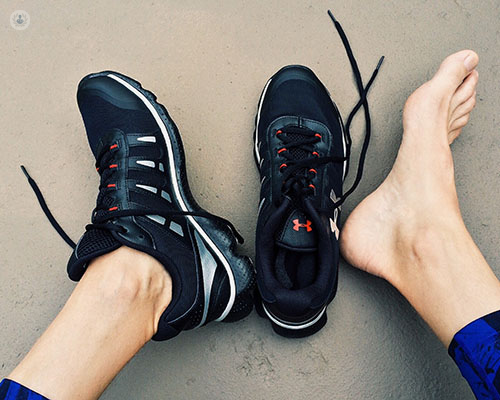Ankle ligament tears: An expert guide
Autore:Mr Simon Moyes is an experienced consultant orthopaedic surgeon, and an expert in the treatment of ankle ligament tears. In his latest article, Mr Moyes explains how this injury is treated in detail.

What is an ankle ligament tear?
A network of ligaments, tendons, and muscles supports and moves the bones of your ankle. Four ligaments join the bones together, and tendons attach muscles to bones.
When you roll over on your ankle, the supportive structures will naturally get stretched.
Because they are less flexible than tendons, ligaments are more prone to tearing than tendons. They may be torn partially or totally, or they may be completely yanked out of the bone where they were anchored.
Your ankle joint's ability to move and other structures may be impacted by a torn ligament. It's not unusual for an ankle sprain to coexist with bone fractures and cartilage damage.
What are the symptoms of an ankle ligament tear?
There are various symptoms of ankle ligament tears, including:
- Swollen ankle joint
- A sensation of instability
- Bruising - can extend into your foot and up your lower leg.
- Tender to touch
- Ankle pain - happens when putting weight on it
- Popping noise when the injury first occurred
When should I seek treatment?
If any of these symptoms appear, you ought to visit a specialist for treatment. Additionally, if you frequently "go over" on your ankle after having a sprain, you probably have a chronic ligament injury.

It is crucial to get treatment as soon as possible since ankle weakness and chronic instability can develop into more severe problems like ankle arthritis.
How are ankle ligament injuries treated?
An accurate diagnosis is the first step in any treatment for a torn ankle ligament. This often includes a physical examination to assess your range of motion, stability, and weight-bearing capacity as well as to evaluate the injury's history.
To evaluate ligament or other soft tissue injury, an MRI or ultrasound scan may be done, and an x-ray may also be required to look for a fracture.
Treatment options depend on the severity of the damage and include:
Non-surgical
Physiotherapy is an excellent way to treat partial ankle ligament damage. Exercises will be taught to you to strengthen the muscles in and around your ankle. This will increase stability and aid in avoiding further injuries.
However, a complete tear will require three weeks of immobilization in an Aircast boot.
Targeted massage can promote blood flow to speed up the healing process, reduce fluid retention, and lessen scar tissue thickening.
Injections
Mr Moyes offers injection therapy to reduce inflammation after a ligament tear.
Surgery
Surgery is usually only recommended if the ligament tear has caused damage to other structures of your ankle, or has resulted in long-term instability or the risk of other conditions such as arthritis.
Ligament tears can be surgically repaired by stitching them back together, re-attaching them to the bone, or replacing them with a graft (a tendon from another part of your body or from a donor).
Most ankle ligament surgery is carried out using keyhole (arthroscopic) surgery.
Mr Simon Moyes is a renowned consultant orthopaedic and sports medicine surgeon based in London. If you would like to book a consultation with Mr Moyes, you can do so today via his Top Doctors profile.


